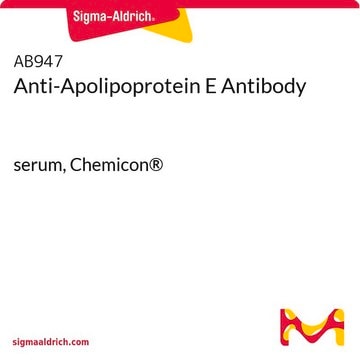SRP3008
APRIL human
recombinant, expressed in Hi-5 Insect cells, ≥95% (SDS-PAGE), ≥95% (HPLC), suitable for cell culture
Sinónimos:
A Proliferating-inducing Ligand, TNFSF13, TRDL-1?
Iniciar sesiónpara Ver la Fijación de precios por contrato y de la organización
About This Item
Código UNSPSC:
12352200
NACRES:
NA.32
Productos recomendados
origen biológico
human
recombinante
expressed in Hi-5 Insect cells
Ensayo
≥95% (HPLC)
≥95% (SDS-PAGE)
Formulario
lyophilized
mol peso
16.3 kDa
envase
pkg of 10 μg
técnicas
cell culture | mammalian: suitable
impurezas
<0.1 EU/μg endotoxin, tested
color
white to off-white
Nº de acceso UniProt
Condiciones de envío
wet ice
temp. de almacenamiento
−20°C
Información sobre el gen
human ... TNFSF13(8741)
Descripción general
APRIL, a member of the TNF superfamily, is expressed in monocytes, macrophages, certain transformed cell lines, certain cancers of colon, and lymphoid tissues. APRIL, along with another TNF family member, BAFF, compete for two receptors, TACI and BCMA. ARPIL has the ability to stimulate proliferation of various tumor cell lines including Jurkat T cells and MCF-7 carcinoma cells. Like BAFF, APRIL also stimulates the proliferation of B and T cells. The human APRIL gene codes for at least four alternatively spliced transcriptional variants, which give rise to different isoforms of the APRIL precursor protein. All isoforms can be cleaved by the protease, furin, to release a soluble C-terminal fragment, which comprises the TNF like receptor binding of the APRIL precursor. Recombinant human APRIL is a soluble 16.3 kDa protein, consisting of 146 amino acid residues. 11
Acciones bioquímicas o fisiológicas
APRIL, a member of the TNF superfamily, is expressed in monocytes, macrophages, certain transformed cell lines, certain cancers of colon, and lymphoid tissues. Recombinant human APRIL is a soluble 16.3 kDa protein, consisting of 146 amino acid residues.
Secuencia
AVLTQKQKKQ HSVLHLVPIN ATSKDDSDVT EVMWQPALRR GRGLQAQGYG VRIQDAGVYL LYSQVLFQDV TFTMGQVVSR EGQGRQETLF RCIRSMPSHP DRAYNSCYSA GVFHLHQGDI LSVIIPRARA KLNLSPHGTF LGFVKL
Forma física
Lyophilized from 20 mM Sodium Acetate, pH 7.5 + 500 mM NaCl.
Reconstitución
Centrifuge the vial prior to opening. Reconstitute in water to a concentration of 0.1-1.0 mg/ml. Do not vortex. This solution can be stored at 2-8°C for up to 1 week. For extended storage, it is recommended to further dilute in a buffer containing a carrier protein (example 0.1% BSA) and store in working aliquots at -20°C to -80°C.
Código de clase de almacenamiento
11 - Combustible Solids
Clase de riesgo para el agua (WGK)
WGK 3
Punto de inflamabilidad (°F)
Not applicable
Punto de inflamabilidad (°C)
Not applicable
Elija entre una de las versiones más recientes:
¿Ya tiene este producto?
Encuentre la documentación para los productos que ha comprado recientemente en la Biblioteca de documentos.
Fabienne Mackay et al.
Cytokine & growth factor reviews, 14(3-4), 311-324 (2003-06-06)
B cell activating factor belonging to the TNF family (BAFF) and apoptosis-inducing ligand (APRIL) are two related members of the TNF ligand superfamily. Although they share two receptors, TACI and BCMA, transgenic and knockout mice in this system reveal that
G Yu et al.
Nature immunology, 1(3), 252-256 (2001-03-23)
We report that the tumor neurosis factor homolog APRIL (a proliferation-inducing ligand) stimulates in vitro proliferation of primary B and T cells and increases spleen weight due to accumulation of B cells in vivo. APRIL functions via binding to BCMA
H B Shu et al.
Journal of leukocyte biology, 65(5), 680-683 (1999-05-20)
Members of the tumor necrosis factor (TNF) family play important roles in modulation of immune responses. We describe the identification and cloning of a novel TNF family member that has been designated as TALL-1. TALL-1 is a 285-amino acid type
Yoshiko Matsuda et al.
Cellular immunology, 295(2), 127-136 (2015-04-17)
Long-lived plasma cells (PCs) contribute to humoral immunity through an undefined mechanism. Memory B cells, but not human naïve B cells, can be induced to differentiate into long-lived PCs in vitro. Because evidence links a proliferation-inducing ligand (APRIL), a tumor
Nuestro equipo de científicos tiene experiencia en todas las áreas de investigación: Ciencias de la vida, Ciencia de los materiales, Síntesis química, Cromatografía, Analítica y muchas otras.
Póngase en contacto con el Servicio técnico







